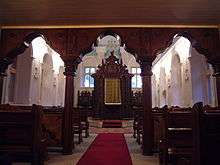Kenesa

Kenesa is the term for a Karaite or Persian synagogue. The word derives from the Aramaic word for "assembly" (in Hebrew, the word for synagogue is beit knesset).
Modern Karaite kenesas are similar to Rabbinical synagogues. In Eastern Europe they are laid out along north-south axis (Jerusalem direction). Starting from the northern entrance, kenesa contains:
- Vestibule (azar), where worshipers take off their shoes. Shoes are not permitted anywhere further.
- Moshav Zekenim (מושב זקנים, old men's pews): wooden benches for the old and the mourners, usually under a low ceiling. The loft above this ceiling is reserved for the women, who remain invisible to the men on the main floor.
- Shulkhan (Aramaic: שולחן "table"): the main hall. Traditional Karaite worship was performed on the knees. In the past, kenesa floors were carpeted; however, modern Karaite kenesas have pews in the main hall.
- Hekhal, or altar (היכל): raised stand for the ritual Ark and the priest.
Some Karaites kenesas also have a rood screen
Surviving kenesas
There were 20 kenesas in the former Russian Empire, nine of them in Crimea (by 1918, two more were added). All surviving kenesas are listed memorial buildings, however, many are in a dilapidated state, and others, like Sebastopol kenesa, although in better shape, are managed by public authorities or private owners, not the Karaite communities. The principal, operating place of Karaite worship in Ukraine is located in Yevpatoria, Crimea. It actually contains two independent kenesas, re-opened to the public in 2005 and 1999.
Kenesas in Lithuania were built in the 14th century; in Trakai, Biržai, Kėdainiai, Panevėžys and Vilnius. An early 20th-century kenesa still stands in Trakai, Lithuania and another one in Vilnius; both are in service. No kenesas survived in Galicia, where Karaites were present since the 13th century, the last kenesa in Halych was destroyed by the Soviets in 1985. The only surviving kenesa in Turkey is in Istanbul, in the Hasköy neighborhood.
Gallery
-

Yevpatoria, Crimea, currently administrated by Russia
-

Chufut-Kale or Juft Qale in Karaim (Джуфт Къале), near Bakhchysarai, Crimea
-

Karaite Kenesa by the architect Gorodetsky in Kiev
References
- Album "Karaite kenassas in Eupatoria and other kenassas of the world", ed. by V. V. Mireyev, Simpferopol, 2006 = Альбом "Комплекс караимских кенасс в Евпатории и другие кенассы в мире", ред. В. В. Миpеев, Cимферополь, 2006


